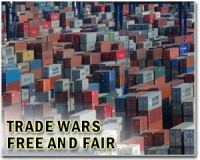| . |  |
. |
Oslo (AFP) Sept 3, 2010 Shipowners are showing growing interest in a fabled trade route to Asia which climate change is beginning to open up at last as polar ice recedes. On Saturday the first non-Russian vessel to make an intercontinental commercial voyage through the Arctic Northeast passage will set sail from Norway for China. The route is thousands of kilometres (miles) shorter than traditional passages, promising to reduce travel time dramatically, along with fuel consumption and carbon dioxide emissions. The Hong Kong-flagged Nordic Barents will sail from the northern port of Kirkenes with 41,000 tonnes of iron ore for Qingdao in China, aided by two Russian icebreakers and taking some 26 days. Its owners, the Danish firm Nordic Bulk Carriers, said the ship would cover only about half the distance of its usual route through the Suez canal, spend eight fewer days at sea and save 180,000 dollars in fuel costs. "It can be very interesting for producers of minerals in Norway, in Sweden or in Finland who want to export their goods to the Asian markets," the company's managing director Christian Bonfils told AFP. The new route mirrors the Northwest passage over the top of Canada, avoiding a massive detour through the Panama Canal and significantly slashing the distance between the Atlantic and Pacific oceans. "For the past 150 years, explorers from around the world have dreamt of the polar passages," Norwegian Foreign Minister Jonas Gahr Stoere said in May. "With climate change, the modernisation of Russia, the discovery of resources in the Great North and new maritime technologies, their vision is closer to becoming reality," he added. Time and money saved taking the Northeast passage -- including the fee charged for passing through the Suez Canal -- is partially offset by other costs such as icebreaker assistance. "But all in all, we're saving money. Otherwise we wouldn't do it," Bonfils said. Opting for the northern route will also allow ships to avoid the danger of pirates and other attacks in the Gulf of Aden and Indian Ocean. Russia, which for decades has used the passage for domestic connections, blazed the trail to China last month with a gas tanker that sailed from northwestern port of Murmansk. In 2009, two German ships also sailed the Northeast passage between South Korea and Rotterdam, but they unloaded their cargo in Russia. "What's new with the Nordic Barents is that she is the first ship with a foreign (non-Russian) flag which is allowed to sail off northern Russia without delivering any cargo to Russia," Bonfils explained. Due to global warming, scientists say they expect the Arctic ice cover to completely disappear during the summer months in coming decades. "The northern route could in time open up new possibilities for transport between the United States, Europe and Asia, and could help improve infrastructure in northern Russia," said Sturla Henriksen, the chairman of the Norwegian Shipowners' Association. But for the foreseeable future, the northern route remains a luxury that will be afforded only to ice-class ships, with reinforced hulls, like the Nordic Barents. So traffic in the area should remain light in the short term at least, Bonfils said. "There are not that many ice-class ships in the world and the window for sailing is small," he said, adding that making the voyage was possible only "between two and four months" each year.
Share This Article With Planet Earth
Related Links Global Trade News
 EU's Ashton urges China on trade, Iran
EU's Ashton urges China on trade, IranBeijing (AFP) Sept 2, 2010 EU foreign policy chief Catherine Ashton urged China Thursday to create a better investment environment for European businesses and maintain a joint stand on the Iranian nuclear issue. Ashton met Premier Wen Jiabao a day after taking part in the inaugural EU-China High-Level Strategic Dialogue in the southwestern city of Guiyang - a forum intended to keep the two sides in contact on major i ... read more |
|
| The content herein, unless otherwise known to be public domain, are Copyright 1995-2010 - SpaceDaily. AFP and UPI Wire Stories are copyright Agence France-Presse and United Press International. ESA Portal Reports are copyright European Space Agency. All NASA sourced material is public domain. Additional copyrights may apply in whole or part to other bona fide parties. Advertising does not imply endorsement,agreement or approval of any opinions, statements or information provided by SpaceDaily on any Web page published or hosted by SpaceDaily. Privacy Statement |